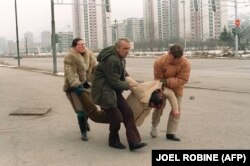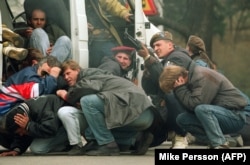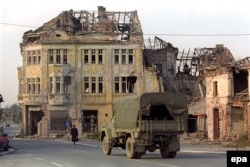The conclusions of a new study out of Belgrade on the role of the Yugoslav People's Army (JNA) in the Balkan wars of the 1990s include one finding that might shock some readers. The Center for Humanitarian Law in the Serbian capital appears to be saying that the army that gave birth to Yugoslavia eventually also destroyed it.
The study covers the decade, from the early 1980s to 1992, leading up to the collapse of the Yugoslav federation and analyzes the transformation of the JNA from an armed force that was as ethnically mixed as the country it was meant to protect, to one that was effectively an ethnic Serb army.
The roots of the JNA lay in the antifascist resistance to the Nazi occupation of Yugoslavia (1941-45). The leader of that resistance movement, and later president of Yugoslavia, Josip Broz Tito, was of Croat-Slovene parentage, and the partisan forces that liberated the country in 1945 reflected its ethnic diversity -- including Serbs, Croats, Muslims, Slovenes, Macedonians, and others. The JNA in the postwar decades was equally mixed and was seen as a bedrock of national unity -- not only in the sense that the army was the country's first line of defense, but also in that it was an institution that instilled the values of togetherness and coexistence.
But his comprehensive new study appears to show that the JNA was not simply a bystander or victim of the breakup of Yugoslavia but was instrumental in its collapse and actively placed itself on the side of ethnic Serbs in Croatia and Bosnia, preparing the ground for, or committing atrocities against, ethnic Croats and Muslims.
Speaking to RFE/RL's Belgrade bureau, the Center for Humanitarian Law's Nemanja Stjepanovic said the roughly 100-page study was published in order to preserve the accounts of perpetrators and victims of war crimes, as well as to show how the JNA transformed itself into a Serb army and chose sides in the conflict.
That alleged transformation, which the study says began in the late 1980s, made it possible for Serbian leader Slobodan Milosevic to take control of the JNA and use it for political ends.
The report arguably marks the first comprehensive study to conclude -- based on documentary evidence -- that the Bosnian Serb Army that seemingly emerged out of nowhere in 1992 was a creation of the JNA, to the extent that units of the JNA simply changed their name and insignia without changing the command structure, equipment supply, or financing.
The ostensible purpose of this JNA-backed Bosnian Serb Army was to defend ethnic Serbs in Bosnia. But in the course of this act of "self-defense," numerous crimes were committed, some directly by the JNA and others with its assistance, according to Stjepanovic, one of the co-authors of the study.
Among other things, Stjepanovic noted that the JNA handed over prisoners of war and captured civilians of other ethnicities to Serb forces (often former JNA units) without regard to their fate.
Dejan Jovic, political science professor at both Zagreb and Belgrade universities, said he believes that all of the former Yugoslav states are guilty of the "selective interpretation" of events of the 1990s, based on the "obscuring or twisting of facts."
Jovic, therefore, highlights the importance of the international tribunal in The Hague, which has brought to light numerous documents that would otherwise have been inaccessible to the public.
The JNA is an especially difficult research subject, Jovic said, because it followed its own rules and documents are hard to come by.
However, Jovic insisted that this new study has shattered the image of the JNA as a force of integration and a “guardian of Yugoslavia.”
Indeed, one of the study's key conclusions is that the disintegration of Yugoslavia and the JNA’s transformation from a "Yugoslav" to a "Serb" army were concurrent, intertwined processes.
Military service was compulsory in Yugoslavia, so nearly every adult male citizen had experienced being part of the JNA, and many developed a bond with the national army. What few could have imagined is that the JNA's guns would be turned on Yugoslav cities, but that is precisely what happened. In 1991, it was the JNA that essentially reduced the Croatian city of Vukovar to rubble, followed by the shelling of Dubrovnik, Karlovac, and others. The following year, it was Sarajevo's turn -- initially fired upon by the JNA before a Yugoslav army morphed into a Bosnian Serb one.
The JNA's role as detailed in the newly published "dossier" recalls my own experience of the start of the war in Sarajevo. In late April 1992, the JNA was shooting at targets throughout the city, including the TV transmitter on Hum Hill that was visible from my balcony. Because it was shaped like a needle, it was not an easy target. Shells were landing all over the place, missing Hum and hitting nearby buildings.
Then came a telephone call. It was from Belgrade’s Radio Politika, which wanted to know what was happening in Sarajevo. At first, I was happy that someone in Belgrade wanted to know what was going on. Breathlessly, I reported on the army's movements and the shelling of the Hum transmitter. A very polite reporter at the other end then asked me if I could repeat what I had just described -- the shelling, the destruction -- and mention all of the locations in the city that were being hit, but that I should avoid mentioning the Yugoslav Army. Radio Politika wanted me to say that I did not know who was doing the shooting. I told the Belgrade reporter: 'I'm sorry, but I can see the red stars on the Yugoslav Army tanks with my own eyes.'
The journalist on the Belgrade end apologized, saying he simply couldn't broadcast a report in which the army is blamed for shooting at civilian targets.
That was the end of our conversation.
I never got another call from a Belgrade-based radio station.
In 1992, it didn't take a Serb nationalist to be incredulous that the JNA, which was meant to protect us all, might be shelling its own people. The truth took a while to sink in, even for those who were the JNA's targets or unintended victims in the early days of the war.
That's what makes these new findings by the Belgrade Center for Humanitarian Law even more significant.








